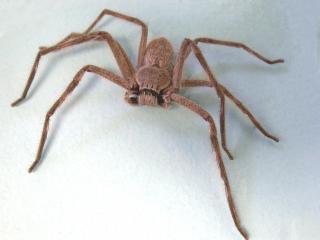Huntsman spiders
Huntsman spiders are in the Sparassidae family and are the large ‘hairy scary’ spiders that absolutely terrify people when they scuttle out from behind a curtain or the sun visor in the car. In reality, Australian huntsman spiders are a fascinating group with 13 genera and 94 described species. Many huntsman spiders live socially in large family groups with the mothers showing extraordinary maternal instinct. These large, hairy grey-brown spiders have flattened bodies and are found throughout Australia, preferring to live outside under the bark of trees or under rocks and logs on the ground. They are typically long-legged (females can reach sizes up to 15cm across the legs) with forward facing legs, and are known for their scuttling sideways gait.
These sure-footed and agile spiders are nocturnal and sometimes seen indoors at night, hunting for insects. They have keen eyesight and are good hunters, running down and pouncing on their prey. None of these spiders spin webs of any kind. Although some huntsman spiders can give a painful bite, they are not considered dangerous to humans.
Wolf spiders
There are hundreds of species of wolf spiders in the Lycosa species distributed very widely across Australia through their ability to disperse aerially as spiderlings. They are also known as lawn or garden wolf spiders by some, as this is where we often encounter them. Most wolf spiders are wanderers but some build burrows, either with or without a trapdoor entrance. Species range in size from 1–8cm across the legs and are distinguished from other ground dwelling spiders by their large eyes used for hunting at night. Like huntsman spiders, wolf spiders are highly maternal and we can sometimes see the mother-to-be roaming with her silken egg sac attached to her underside, or marvel at her piggy-backing dozens of her young.
Most wolf spiders are typically drab brown-grey with variegated black or fawn patterns on them. They are not dangerous to humans, although one species can give a painful bite, which has been known to cause blistering skin lesions and infection. For this reason you should consider wearing gloves when gardening.

